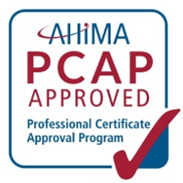These codes enable the health care industry to collect, process, and send information more effectively. This organized system of codes is a language used by health care providers and insurance companies to tell the story of why a patient was seen and what treatments the patient received.
- Medical coders may become inpatient or outpatient coders, auditors, clinical documentation specialists, insurance evaluators, case reviewers, teachers or compliance officers. They work in the public and private sectors for physician offices, laboratories, hospitals, nursing homes, insurance companies, and government agencies. Many coders work remotely from home for all or part of their work schedule.
- Medical coding professionals enjoy financial security working in the healthcare industry and with an annual growth rate of 9%.
- Becoming a medical coder doesn't require a four-year college education — or even a two-year college education. You can transition to this profitable and well-respected career path in as few as eight months.
- The need for continues to increase with our aging population. The U.S. Bureau of Labor Statistics projects a 7% rise in jobs by 2028 — "much faster than the average for all occupations."
Laurie Vilord Discusses Medical Coding on "WTBR's Morning Drive"
Medical Coding (Certificate)
The Medical Coding and Health Information Management Department is designed to meet the needs of students at different stages of their careers; whether just starting out, returning to school for a second career, studying part-time at night to enhance a full- time job during the day, or looking toward promotion in the field. The Medical Coding and Health Information Management Certificates are designed to stack one on the other to facilitate a pathway in these careers. Each certificate can be completed in two semesters.
Learn More
-
AHIMA Professional Certificate Approval Program (PCAP)
ºìÐÓÖ±²¥'s Medical Coding program is approved by the American Health Information Management Association (AHIMA) Professional Certificate Approval Program (PCAP). This designation acknowledges the coding program as having been evaluated by a peer review process against a national minimum set of standards for entry-level coding professionals. This process allows academic institutions to be acknowledged as offering an approved coding certificate program.
The AHIMA PCAP designation:
- Identifies specialized programs that meet established coding educational standards
- Stimulates improvement of educational standards through faculty development opportunities, and by involving faculty and staff in program evaluation and planning
- Promotes a better understanding of the goals of professional coding education
- Provides reasonable assurance that practitioners possess the necessary job skills upon entry into the profession
-
Local Trends
The largest industries in Berkshire County, MA are healthcare and social assistance (11,413 people).
-
National Trends
- Medical Coding is among the 20 fastest growing occupations with a national anticipated growth of 18.2% by year 2028. (U.S. Bureau of Labor Statistics)
- The — above the median salary of all . Your earning potential rises to $64,712 when you add another certification demonstrating broader coding expertise.
- The is at a historic high. Fueled by the healthcare needs of an aging population, the U.S. Bureau of Labor Statistics projects job opportunities for professional coders to grow 7% in the next decade.
- A growing number of healthcare organizations outsource their coding, giving certified professionals the opportunity to work remotely. , 51% of respondents work from the convenience and comfort of home.
-
Expected Outcomes
Graduates of this program should be able to:
- Describe the anatomy and physiology of the human body;
- Show proficiency in the application of medical terminology;
- Demonstrate strong computer skills; and
- Be eligible to take the CPC (Certified Professional Coder) offered by the AAPC (American Association of Professional Coders) credentialing exam which will qualify a student for entry level coding positions in health care facilities and/or provider clinics and offices.
-
Healthcare Facilities
88% of Healthcare Facilities surveyed recently had immediate openings in their Health Information Management Departments.
67% of these facilities anticipated openings in their Health Information Departments in the coming year.
78% of Hiring Managers anticipated openings within the next two to five years.
-
Local Employers
- Baystate Health Systems
- Berkshire Health Systems
- Columbia Memorial Hospital
- Ellis Medicine
- Holyoke Hospital
- St. Peter's Health Partners
- Saratoga Hospital
- Veteran's Affairs Medical Center; Leeds, MA
- Stratton VA Medical Center; Albany, NY

Contact Us
Fully Online Option
Laurie Vilord, Program Advisor
lvilord@berkshirecc.edu
413-236-4682

Medical Records Specialist Wages in MA*
- Median hourly wage: $28.31
- Annual mean wage: $58,890
*Source:

